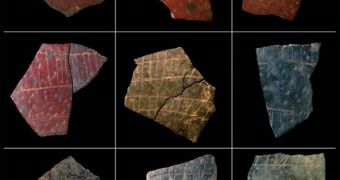African hunter-gatherers were apparently not the savage bunch many anthropologists today paint them to be. Long before the advent of fiber-optic-based communication, our ancestors used ostrich egg shells to engrave geometrical designs and other concepts on an enduring material. This happened more than 60,000 years ago, long before the advent of organized agriculture, and of any form of city. The finding also demonstrates that existence of symbolic forms of communication between individuals living so far back, eroding the common belief that this type of symbolist capabilities developed in humans later on.
In a new study, experts discovered about 270 eggshell fragments, each of them engraved with peculiar geometrical patterns. They were unearthed from the Diepkloof Rock Shelter in South Africa, where the past several years have been extremely fruitful in terms of scientific return to the effort placed in excavating the site. The team handling the location was composed of scientists from the University of Bordeaux 1, in Talence, France, who were led by archaeologist Pierre-Jean Texier, Wired reports.
Two predominant patterns were discovered engraved by the relics, each of which had its own period of more intense use, between 65,000 and 55,000 years ago. The eggshells were written on by the famous Howiesons Poort culture, which anthropologists and archaeologists already know to have played a very important role in the region. The people of the time are believed to have been responsible for producing engraving designs into pieces of pigment, so they were not at their first attempt with symbolic representations. Additional details of the findings appear in the latest issue of the respected journal Proceedings of the National Academy of Sciences.
The treasure trove found at Diepkloof also represents a historical certification of a long-held theory, which states that Stone Age people were among the first to pass down design traditions from generation to generation, at least as far as engravings go. According to Texier, it could be that the patterns found on the eggshell represent a group's testimony that the shells were theirs, and signified a warning for anyone attempting to take them. The practice was not at all uncommon among hunter-gatherers in the Stone Age, anthropologists say.
“The Diepkloof engravings were clearly made for visual display and recognized as such by a large audience comprising members of a community, and probably members of related communities,” adds researcher Francesco d’Errico, who was not a part of the research team. He is also an archaeologist at the University of Bordeaux 1.

 14 DAY TRIAL //
14 DAY TRIAL //